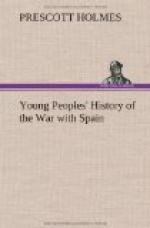The town of El Caney, four miles northeast of Santiago, lies in a broad valley. Beyond it, on the Santiago side, is a high, level piece of country. The houses in the town are built of stone, and have thick walls. The town was protected by a stone fort on a hill, and also by log forts, trenches, and covered places, where the Spaniards could stay under shelter while they fired. The stone fort on the hill was first attacked by our men, and if they had had more heavy cannon the work might have been easy. As it was, more than half the day passed, and, in spite of the hard work of our men, the fort still stood. Our men had no smokeless powder, and their firing made a big black cloud around them all the time, so that they could not see clearly. At last the stone walls of the fort began to weaken, and then our men were ordered to “storm.” They ran along the valley, broke through fences of barbed wire, and went up the hill with such a rush that the Spaniards could not meet them, but fled down into the town. The other forts kept up firing for a while, but our men, now having the fort on the hill, forced the Spaniards farther and farther, and, by four o’clock, our men held the town. The whole place was strewn with dead Spaniards, and our own loss was heavy. Both sides had fought bravely, and the struggle had lasted nearly nine hours.
[Illustration: General Henry W. Lawton.]
At El Caney the Spaniards made the strongest resistance that the American army met in Cuba. One of the foremost figures in this battle was Brigadier-General Henry W. Lawton. I must tell you something about him. Lawton was but seventeen years old when the Civil War in this country broke out. He enlisted at once and was made a sergeant in an Indiana regiment. When his term of service expired he re-enlisted and fought gallantly throughout the remainder of the war. After the war was over Lawton enlisted in the regular army and was sent to the frontier, where he developed into one of the best Indian fighters in the army. When our country went to war with Spain, Lawton was holding an important position in the War Department at Washington. His splendid services were remembered and he was promoted to be a brigadier-general of volunteers and sent to Cuba. After the war with Spain was over, Lawton was again promoted, and in 1899 was sent to the Philippines to assist in putting down the Filipino insurrection.
[Illustration: Battle of El Caney.]
Meanwhile, our other regiments had been ordered to attack San Juan, a village on steep heights, less than a mile east of Santiago. Our men went to the place by two different roads, and had to go through woods, wade through streams, and wind along narrow paths. A number of men from each regiment went before, with tools, and cut the fences of barbed wire. Fences of barbed wire had been put, like a network, all around Santiago, to keep our men away.
[Illustration: Assault of San Juan Hill.]




